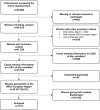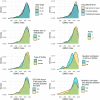Quality of maternal and newborn care in Switzerland during the COVID-19 pandemic: A cross-sectional study based on WHO quality standards
- PMID: 36530005
- PMCID: PMC9877813
- DOI: 10.1002/ijgo.14456
Quality of maternal and newborn care in Switzerland during the COVID-19 pandemic: A cross-sectional study based on WHO quality standards
Abstract
Objective: To explore quality of maternal and newborn care (QMNC) in healthcare facilities during the COVID-19 pandemic in Switzerland.
Methods: Women giving birth in Switzerland answered a validated online questionnaire including 40 WHO standards-based quality measures. QMNC score was calculated according to linguistic region and mode of birth. Differences were assessed using logistic regression analysis adjusting for relevant variables.
Results: A total of 1175 women were included in the analysis. Limitations in QMNC during the pandemic were reported by 328 (27.9%) women. Several quality measures, such as deficient communication (18.0%, n = 212), insufficient number of healthcare professionals (19.7%, n = 231), no information on the newborn after cesarean (26.5%, n = 91) or maternal and newborn danger signs (34.1%, n = 401 and 41.4% n = 487, respectively) suggested preventable gaps in QMNC. Quality measures significantly differed by linguistic region and mode of birth. Multivariate analysis established a significantly lower QMNC for women in French- and Italian-speaking regions compared with the German-speaking region. Moreover, in several quality indicators reflecting communication with healthcare providers, women who did not answer the questionnaire in one of the Swiss national languages had significantly worse scores than others. A significant lower QMNC was also found for young and primiparous women and for those who experienced cesarean or instrumental vaginal birth.
Conclusion: Women giving birth in Switzerland during the pandemic reported notable gaps in QMNC. Providers should be attuned to women who are younger, primiparous, and those who had an emergency cesarean or instrumental vaginal birth given the lower QMNC reported by these groups. Women who did not respond in a Swiss national language may need improved communication strategies.
Keywords: COVID-19; IMAgiNE EURO; Switzerland; WHO standards; maternal health; maternity services; mode of birth; quality of care.
© 2022 The Authors. International Journal of Gynecology & Obstetrics published by John Wiley & Sons Ltd on behalf of International Federation of Gynecology and Obstetrics.
Conflict of interest statement
The authors have no conflicts of interest to declare.
Figures




Similar articles
-
Quality of care at childbirth during the COVID-19 pandemic in Belgium: a cross-sectional study based on WHO standards.BMJ Open. 2024 Dec 27;14(12):e086937. doi: 10.1136/bmjopen-2024-086937. BMJ Open. 2024. PMID: 39732493 Free PMC article.
-
Trends in the quality of maternal and neonatal care in Sweden and Norway as compared to 12 WHO European countries: A cross-sectional survey investigating maternal perspectives during the COVID-19 pandemic.Acta Obstet Gynecol Scand. 2024 Dec;103(12):2485-2498. doi: 10.1111/aogs.14994. Epub 2024 Oct 21. Acta Obstet Gynecol Scand. 2024. PMID: 39431577 Free PMC article.
-
Quality of maternal and newborn care around the time of childbirth in Luxembourg during the COVID-19 pandemic: Results of the IMAgiNE EURO study.Int J Gynaecol Obstet. 2022 Dec;159 Suppl 1(Suppl 1):113-125. doi: 10.1002/ijgo.14473. Int J Gynaecol Obstet. 2022. PMID: 36530011 Free PMC article.
-
Women 's perception on the quality of maternal and newborn care during the COVID-19 pandemic in German-speaking countries: Findings from the IMAgiNE EURO project comparing data from Germany, Switzerland and Austria.Midwifery. 2025 Jan;140:104209. doi: 10.1016/j.midw.2024.104209. Epub 2024 Oct 11. Midwifery. 2025. PMID: 39423767
-
Women's perspectives on the quality of maternal and newborn care in childbirth during the COVID-19 pandemic in Latvia: Results from the IMAgiNE EURO study on 40 WHO standards-based quality measures.Int J Gynaecol Obstet. 2022 Dec;159 Suppl 1(Suppl 1):97-112. doi: 10.1002/ijgo.14461. Int J Gynaecol Obstet. 2022. PMID: 36530013 Free PMC article.
Cited by
-
Quality of care at childbirth during the COVID-19 pandemic in Belgium: a cross-sectional study based on WHO standards.BMJ Open. 2024 Dec 27;14(12):e086937. doi: 10.1136/bmjopen-2024-086937. BMJ Open. 2024. PMID: 39732493 Free PMC article.
-
Trends in the quality of maternal and neonatal care in Sweden and Norway as compared to 12 WHO European countries: A cross-sectional survey investigating maternal perspectives during the COVID-19 pandemic.Acta Obstet Gynecol Scand. 2024 Dec;103(12):2485-2498. doi: 10.1111/aogs.14994. Epub 2024 Oct 21. Acta Obstet Gynecol Scand. 2024. PMID: 39431577 Free PMC article.
-
Women's experiences of disrespect and abuse in Swiss facilities during the COVID-19 pandemic: a qualitative analysis of an open-ended question in the IMAgiNE EURO study.BMC Pregnancy Childbirth. 2024 May 31;24(1):402. doi: 10.1186/s12884-024-06598-6. BMC Pregnancy Childbirth. 2024. PMID: 38822258 Free PMC article.
References
-
- World Health Organization . Standards for Improving Quality of Maternal and Newborn Care in Health Facilities. WHO; 2016.
-
- International Confederation of Midwives . Women's rights in childbirth must be upheld during the coronavirus pandemic. 2021.
-
- World Health Organization . COVID‐19: Operational Guidance for Maintaining Essential Health Services During an Outbreak. WHO; 2020.
-
- de Labrusse C, Ramelet AS, Humphrey T, Maclennan SJ. Patient‐centered care in maternity services: a critical appraisal and synthesis of the literature. Womens Health Issues. 2016;26:100‐109. - PubMed
MeSH terms
LinkOut - more resources
Full Text Sources
Medical

